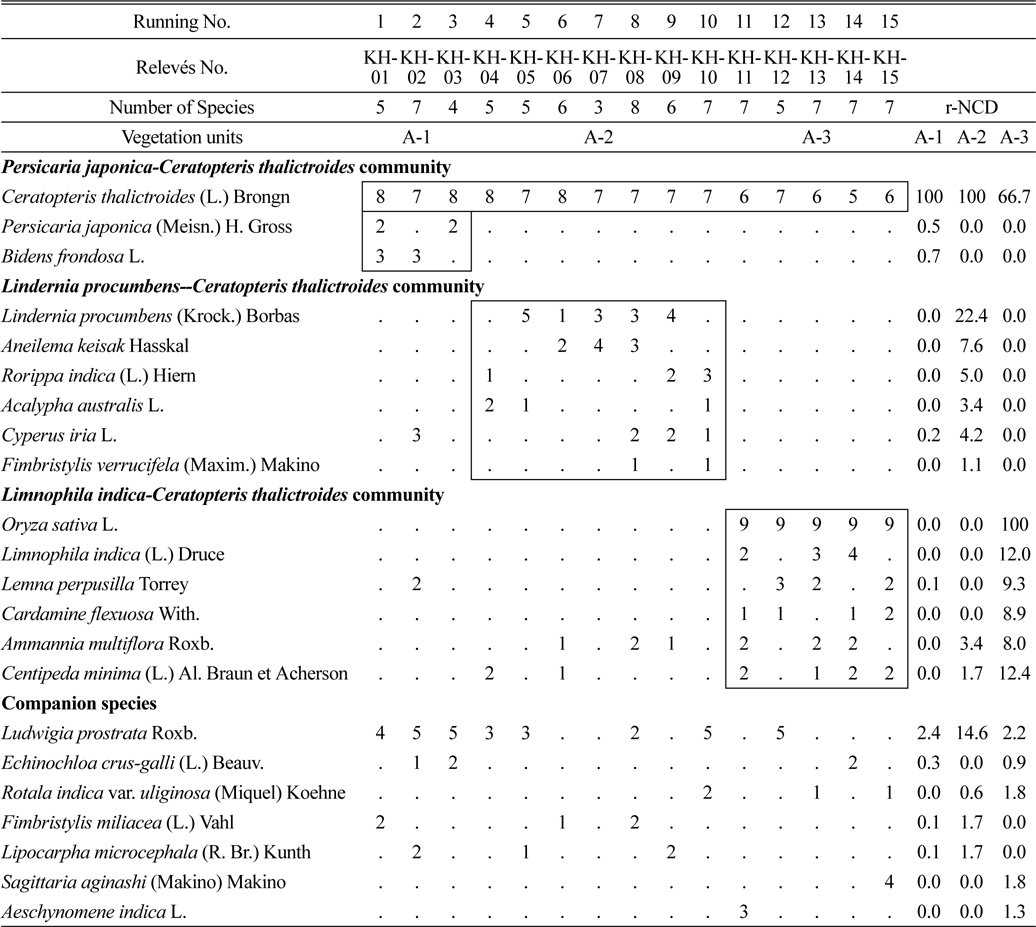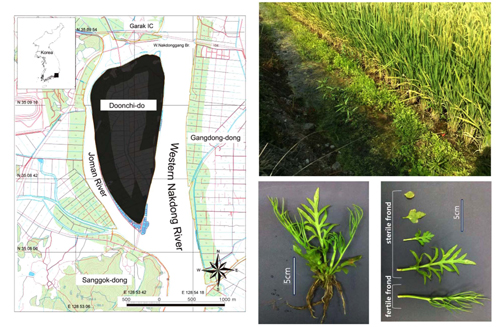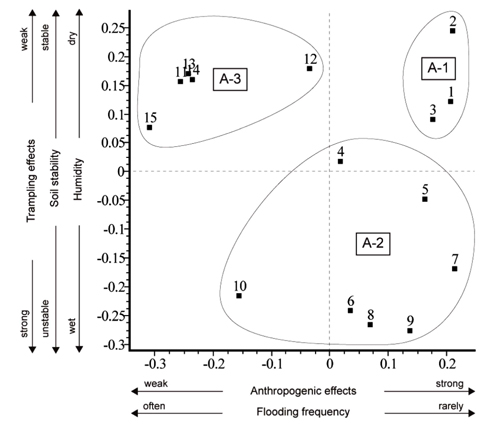



본 연구는 멸종위기 II급 식물인 물고사리의 낙동강 유역권 분포와 자생지에 발달하고 있는 식물군락의 식물사회학적 특성을 밝히고자 이루어졌다. 식물사회학적 연구는 Z.-M. 학파의 방법에 의해 수행되었으며, 전통적 분류방법과 수리통계적 분류방법이 동시에 고려되었다. 물고사리우점군락은 둔치도 일대에 분포하고 있으며, 종조성에 의해 물고사리-흰꽃여뀌군락, 물고사리-밭뚝외풀군락, 물고사리-민구와말군락으로 구분되었다. 군락을 결정짓는 주요환경요소는 수분환경, 입지안정도, 답압의 영향, 인위적 관리에 의한 이차적 에너지 투입, 범람의 빈도 등인 것으로 밝혀졌다. 군락 구성종 가운데 물고사리의 상대기여도가 지배적인 고유식생형으로 분포하고 있음이 밝혀졌으며, 주기적인 간섭에 적응되어 일년생식물의 구성비율이 월등히 높은 것으로 확인되었다. 현재와 같은 전통농법이 유지될 경우 자생지를 중심으로 점차적으로 분포를 넓혀갈 것으로 판단되며, 군락과 서식처에 대한 지속적인 모니터링 연구가 요구된다.
This study is aimed at classifying the syntaxa of
낙동강 하류역에서 물고사리 자생분포지가 확인되었으며, 2013년 5월부터 9월까지 현장조사가 이루어졌다(Fig 1). 행정구역상 부산광역시 강서구 봉림동의 둔치도 일대이며, 35°08′54″N, 128°53′36″E, 1m a.s.l. 을 중심으로 분포하고 있다.
식물사회학적 방법에 의해 서식처에 대응되는 식물군락의 종조성적 특성이 분류, 분석되었다. 식물군락에 대한 연구는 구성종의 종조성 요소를 크게 강조한 Zurich-Montpellier (Z.-M.) 학파의 방법에 의해 이루어졌다(Kim, 2006). 군락조사를 위한 조사지의 선정은 동질한 환경조건과 균질한 종조성을 나타내는 입지에 대하여 이루어졌으며, 조사구의 크기는 식물종 및 식생정보를 온전히 포함한 식생고의 제곱이상에 해당하는 적정면적에 대하여 수행하였다(Kim and Manyko, 1994; Van der Marrel, 2005). 조사구 내에 출현하는 구성종의 피도계급은 변환통합우점도(9계급: 1, 2, 3, 4, 5, 6, 7, 8, 9; Westhoff and Van der Maarel, 1973)를 활용하였다. 식생단위 추출을 위하여 전통적인 분류방법과 함께 수리 통계적 분류방법이 동시에 고려되었으며, 반복적인 진단종군 추출과정을 통하여 서식처에 대응하는 단위식생을 도출하였다. 서식처 환경요인은 식생조사표를 이용하여 제반특성(경위도, 해발고도, 미세지형, 면적, 경사도, 방위, 토양, 토질 등)을 기재하고, 각 조사구 내 종들의 행동양식을 면밀하게 기록하였다. 물리적 환경요소 주요환경요인 발굴을 위한 통계프로그램(Syntax 2000)활용에서는 순차척도(ordinal scale)의 속성을 고려한 NMDS(non-metric multidimensional scaling) method를 이용하여 Podani’s discordance계수에 의한 분석이 이루어졌다(Podani 2001). 이를 통해 획득된 좌표결정(ordination analysis)결과를 통해 개개 군락과 환경요인과의 유의관계가 도출되었으며, 집괴분석(clustering analysis)에 의한 군락 이질도(dissimilarity) 분석을 통해 재검되었다. 각 식생단위에 대한 출현종의 행동양식을 파악하기 위하여 해당식물사회의 출현종에 대한 양적, 질적 평가를 통합한 상대기여도(r-NCD: Kim and Manyko, 1994)를 산출하였으며 각 단위식생에 대한 신뢰도를 수치화하였다(Kim and Lee, 2006).NCDi (기여도)= ∑ Ci / N×ni / N (Cmin ≤ NCD ≤ Cmax) r-NCDi (상대기여도) = NCDi / NCDmax×100
수식에서 ∑ Ci: 군락 내의 i종의 피도 적산값, N: 전체조사구 수, ni: i종이 출현한 조사구수, NCDi: 대상식물군락에 대한 i종의 기여도, NCDmax: 대상군락 내의 기여도 최대값을 의미한다. 발굴된 단위식생의 명명은 국제식생명명규약(Weber et al., 2000)에 따랐으며, 출현 식물종명은 Lee(1996 a,b)와 Lee(2003)를 기준으로 하였다. 그 외 최근 발표된 신종 및 미기록종은 발표 투고논문을 기준으로 참고하였다.
본 조사를 통해 확인된 물고사리우점군락은 종조성 및 서식처 환경에 의해 1)물고사리-흰꽃여뀌군락(
[Table 1.] Synthesized table of Ceratopteris thalictroides dominant communities on Nakdong River.

Synthesized table of Ceratopteris thalictroides dominant communities on Nakdong River.
단위식생의 진단종은 물고사리, 흰꽃여뀌, 미국가막사리 등이다(Table 1; no.1~3). 단층 또는 이층의 식생구조를 가지며, 최고 식생고는 35 cm 내외인 것으로 나타났다. 평균출현종수는 5.3(±1.25)종이며, 물고사리가 가장 높은 상대기여도(100)로 출현하였다. 논경작지 도랑(ditch)을 따라 분포하는 식물군락이며, 연중 얕은 수심이 유지되는 과습한 입지로 산발적인 범람을 경험하는 서식처이다. 범람이 발생 시 수위변화로 인해 침수되는 저수위 입지의 식물들은 쉽게 고사되며, 수위변화에 상대적으로 안정된 입지에 분포하는 종들에 의해 이후 군락이 형성되어 구성종의 종조성이 비교적 가변적인 특징을 보인다. 물고사리우점군락 가운데 인위적 관리의 빈도가 상대적으로 낮은 입지로서, 범람에 의한 자연적인 수위변화 교란요소에 의해 지속적인 퇴행천이를 경험한다. 그로인해 입지의 잠재적 식생형으로 고려되는 고경초본식물군락인 갈대군강(Phragmitetea)으로의 천이가 진행되지 않고 천이초기 형태의 서식처 환경이 지속되는 식물군락으로 판단된다.
단위식생의 진단종은 물고사리, 좀부처꽃, 중대가리풀, 밭뚝외풀, 사마귀풀, 개갓냉이, 푸른하늘지기 등이다(Table 1; no.4~10). 연구지역의 물고사리 자생 서식처 가운데 가장 높은 빈도와 피도로 물고사리가 출현하는 식물군락이 다. 단층의 식생구조를 나타내며, 최고 식생고는 15 cm 내외이다. 평균 출현종수는 5.7(±1.48)종이며, 물고사리가 가장 높은 상대기여도(100)로 출현한다. 논경작지의 두렁(ridge)에 주로 분포하며, 주기적/비주기적인 답압이 행해지는 입지이다. 노상노방식생(Plantagetea)의 구성종이 일부 혼생하기도 한다. 그러나 물고사리는 전초가 비교적 연약한 식물체를 형성하고 있어 상대적으로 답압의 영향이 적은 논두렁 내측에 보다 높은 출현빈도를 보이는 것으로 확인되었다. 물고사리우점군락 가운데 가장 높은 인위적 간섭이 이루어지는 단위식생이며, 경쟁관계에 있는 다수의 다년생 초본식물이 혼생하기도 한다.
단위식생의 진단종은 물고사리, 벼, 민구와말, 좀개구리밥, 황새냉이 등이다(Table 1; no. 11~15). 현재 벼가 재배되고 있는 경작지에 분포하는 식물군락이다. 이층의 식생구조를 나타내며, 초본 1층은 재배작물인 벼에 의해 단순우점하는 구조를 보인다. 최고식생고는 초본1층이 45 cm 내외, 초본 2층이 12 cm 내외이며, 평균 출현종수는 6.6(±0.8)종이다. 벼가 가장 높은 상대기여도값(100)을 나타내며, 물고사리는 두 번째로 높은 값(66.7)으로 출현하였다. 재배작물인 벼에 의해 형성된 반음지 환경에서도 높은 출현경향을 보이지만, 재배작물의 밀집도가 높은 경작지 내측에서는 분포가 급격히 감소하는 특징을 보인다. 연중 습윤한 수분환경과 함께 비교적 안정적인 점토질 토양권이 형성된 입지에서 발달한다. 벼 수확과 함께 토양환경의 건조화가 진행되는 시기에는 군락피도가 급격히 감소하며 포자형성과 함께 잠복기에 접어들거나 수분환경이 유지되는 논두렁 및 도랑서식처를 피난처로 생육을 이어가는 경향을 보인다.
물고사리우점군락의 군락 결정요인은 수분환경, 입지안정도, 답압의 영향, 인위적 관리에 의한 이차 에너지 투입, 범람의 빈도 등인 것으로 밝혀졌다(Fig 2). 물고사리-흰꽃여뀌군락과 물고사리-민구와말군락의 경우 수분환경에서 비교적 습윤한 입지를 선호하며, 토양의 이동이 적고 답압의 영향이 약하게 작용하는 입지에서 분포하는 것으로 확인되었다. 물고사리-흰꽃여뀌군락과 물고사리-밭뚝외풀군락은 인위적 관리에 의한 이차 에너지 투입에 지속적인 영향을 받으며, 안정적인 수위환경이 유지되어 범람의 빈도가 낮은 서식처 환경에서 나타나는 것으로 밝혀졌다. 물고사리의 출현빈도와 피도가 가장 높은 물고사리-밭뚝외풀군락의 경우 논경지에 해당되나 수분환경이 다소 빈약하고 토양의 이동과 답압의 빈도도 비교적 높다. 또한 인위적 에너지투입과 수위제어에 따른 안정적인 수위구조에 대해서도 적응되어 있어 인위식생형(anthropogenic vegetation types)이면서, 기회중심적 식물군락인 것으로 판단된다.
이들 군락이 분포하는 낙동강 하구역은 현재에도 전통적인 농법에 의한 벼경작이 이루어지고 있는 지역으로서 주기적인 자연물에 의한 논둑형성, 논뚝 돋우기, 물길확보에 의한 수위조절, 자연도랑 유지, 지속적인 잡초예취 등의 행위가 유지되고 있다. 따라서 전통농법이 인접지역에서도 동일하게 적용될 경우 물고사리의 분포는 낙동강하류역을 중심으로 점차적으로 그 서식처 범위를 넓혀갈 것으로 판단된다.
물고사리우점군락의 구성종 상대기여도(r-NCD) 분석 결과 경작지 내에 분포하는 물고사리-민구와말군락을 제외한 모든 군락에서 물고사리가 가장 높은 상대기여도를 나타내었다(Table 1, Fig 3). 이들 군락 가운데 물고사리-밭뚝외풀군락과 물고사리-민구와말군락은 물고사리를 제외하면 10이상의 상대기여도를 나타내는 종은 밭뚝외풀(22.4), 여뀌바늘(14.6), 중대가리풀(12.4), 민구와말(12) 뿐이며, 물고사리-흰꽃여뀌군락에서도 3종(여뀌바늘, 미국가막사리, 흰꽃여뀌)만이 10이상의 상대기여도를 보였다. 이것은 물고사리가 논경작지 잡초군락의 수반종으로 우연 출현하는 종이 아닌 고유한 식생형으로의 지위(niche)를 가지고 있음을 의미하며, 물고사리에 의존적인 군락 종조성을 구성하고 있음을 뜻한다. 물고사리를 제외한 진단종의 상대기여도 평균을 바탕으로 의존정도를 파악한 결과 물고사리-밭뚝외풀군락(4.07±6.54), 물고사리-민구와말군락(5.87±4.7), 물고사리-흰꽃여뀌군락(13.95±19.66)의 순인 것으로 나타났다.
전체 출현종의 일이년생식물과 다년생식물의 비율은 일이년생식물이 월등히 높은 값(82.6%)을 나타냈으며, 주기적 교란이 발생하는 입지에 적응된 식생형임을 반증하는 결과로 판단된다(Han et al., 1998). 구성종의 휴면형은 물고사리-흰꽃여뀌군락과 물고사리-민구와말군락에서 일년생식물, 습생식물(습생 일년생, 습생 부유식물 포함)의 출현경향이 유사하게 나타났다(Fig 3). 반면 물고사리-밭뚝외풀군락의 경우 습생 다년생식물과 부유식물이 출현하지 않고 습생 일년생식물의 분포비가 월등히 높게 출현한다. 이것은 물고사리-밭뚝외풀군락이 수위가 보장되는 입지가 아니며, 상대적으로 인위적 간섭에 강하게 노출되어 있다는 앞선 결과와 동일한 의미를 갖는다(Kang et al., 2003). 겨울형 일년생식물은 물고사리-흰꽃여뀌군락에서 출현하지 않는데, 이는 연중 수분조건이 보장되는 도랑 입지에 서 건조한 입지를 중심으로 분포하는 월년성 로제트형 식물의 분포가 극히 제한적인 한국 전체 식물상의 특징과 일치하는 결과이다(Lee, 1996a).



